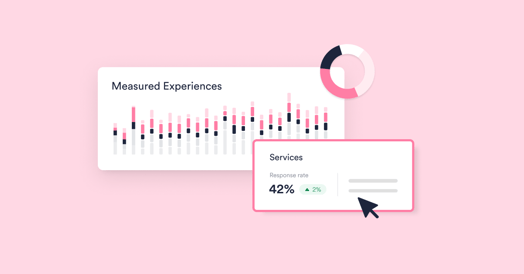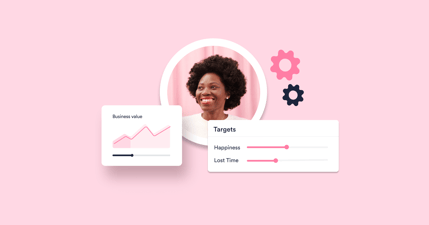The IT experience management (ITXM) landscape currently has two dominant approaches. HappySignals advocates direct end-user, i.e. human, feedback. Meanwhile, the Digital Employee Experience (DEX) approach relies on endpoint data and key performance indicators (KPIs) to create aggregated scores. In addition, a growing industry trend combines both data sources, focusing on enhancing the modern digital workplace experience.
Understanding the benefits and trade-offs of both approaches is crucial for IT organizations in the rapidly evolving ITXM field.
How to define and measure IT experience
To navigate the ITXM landscape, your IT organization must first define and measure the end-user experience. At HappySignals, we take a human-centric approach, in which the end-user’s perspective of their experience takes precedence. This ITXM perspective is similar to taking a car with a warning light to a garage and returning to find it fixed. For the end-user, it’s an end-to-end view of the experience, while the diagnostic and resource planning steps are only for internal (garage) purposes.
People, process, technology – importantly, in this order
In the world of internal IT, end-users often lack a choice with the technologies and services they are allowed to use. This means some telemetry-based metrics, such as usage time, don’t indicate any more than how long the application was used. And just because someone uses an application extensively doesn’t mean they’re having a positive experience. Perhaps the end-user doesn’t know how to use the application, and this is the cause of the long use time.
At HappySignals, we believe that taking a human-centric IT experience approach helps organizations to drive better decision-making because it highlights the improvement opportunities that matter most to end-users. While analyzing the process and technology plays a role, this can’t replace direct feedback from end-users.
Defining experience in XLAs
When prioritizing and understanding end-user experiences, there’s a need to ask end-users how they feel about their IT touchpoints, preferably continuously, to build up a steady stream of experience data. This approach of asking for end-user feedback means many can and sometimes will decide not to provide feedback. This issue is why end-user response rates are often discussed when onboarding new ITXM customers.
Some organizations feel that process and technology data can remove the reliance on end-user feedback, such that end-user feedback is omitted from experience level agreement (XLA) KPIs. This can and has already started to create “XLA watermelons,” similar to the symptoms originally seen with service level agreements (SLAs) that brought about the “experience movement.”
This issue was highlighted in recent Gartner research . Gartner stated that:
“... (IT) providers often disguise legacy SLAs as XLAs for clients, driving the wrong perception about the effectiveness of XLAs.”
Sadly, clients often lack a proper understanding of what an XLA KPI is and, therefore, cannot articulate their requirements properly, leading to uncertainties and dissatisfactions related to implementation.
Humans are the best sensor
It can sound cliché, but humans are still the best sensor when evaluating the quality of IT experiences. Technology metrics and data analysis can provide valuable insights. However, they can never fully capture the nuances and emotions that end-users experience. This subjective end-user feedback is essential for organizations to understand how their IT services are truly perceived and used.
Prioritizing the “voice” of the end-user allows organizations to gain a deeper understanding of the end-users’ needs, frustrations, and expectations. This insight enables IT decision-makers to then make informed choices – related to changes and investments – that better align with the actual end-user experience. Thus leading to IT improvements in the areas that matter most to those using the technology.
Choosing a human-centric IT experience approach acknowledges that technology data alone cannot fully capture the end-user’s perspective of whether the technology is helping or hindering their productivity.
Final takeaway
Our H1 2023 ITXM research data shows a human-centric approach to experience management significantly benefits organizations. The analysis of this experience data, from different perspectives, presents a holistic snapshot of how end-users experience enterprise IT. But please note that the data in the report is from HappySignals customer organizations that have already embraced a human-centric approach to ITXM.
Based on the customer use of their experience data, one of the main benefits of ITXM is the ability of enterprise IT leaders to bring about data-driven change. They can prioritize the needs and experiences of employees and make informed decisions to improve employee productivity and the associated business outcomes. Additionally, focusing on human-centric experience management can help your organization transform its IT culture, making the IT organization more empathetic and responsive to the needs of employees.
Another key ITXM benefit is the impact on employee happiness. Prioritizing a positive employee experience means that organizations can improve employee retention rates and reduce staff turnover costs. Happy employees are also more engaged and productive, which leads to improved business outcomes. Everyone wins by prioritizing employee experiences and focusing on data-driven decision-making – IT organizations achieve better outcomes for employees and the business as a whole.
Intrigued? Discover more about experience management by reading the HappySignals IT Experience Management Framework™ Guide. This 10-page download introduces ITXM and how best to lead human-centric IT operations with better experiences as a key outcome.




